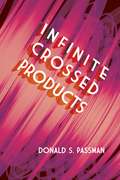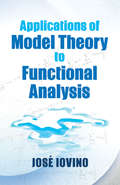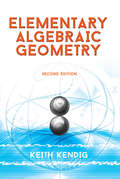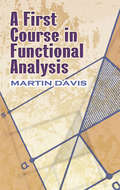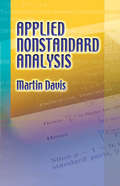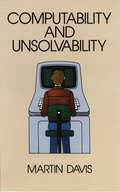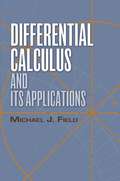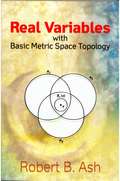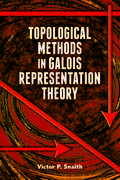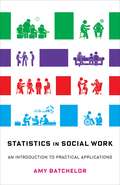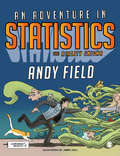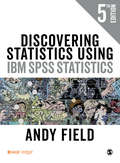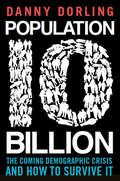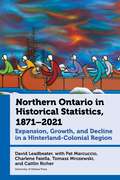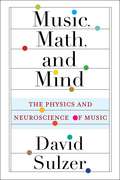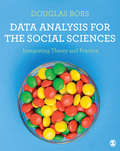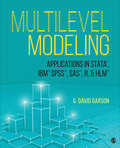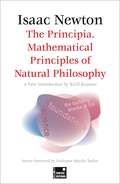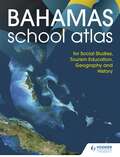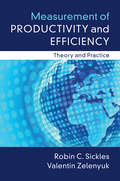- Table View
- List View
Infinite Crossed Products (Dover Books on Mathematics #Volume 135)
by Prof. Donald S. PassmanThis groundbreaking monograph in advanced algebra addresses crossed products. Author Donald S. Passman notes that crossed products have advanced from their first occurrence in finite dimensional division algebras and central simple algebras to a closer relationship with the study of infinite group algebras, group-graded rings, and the Galois theory of noncommutative rings. Suitable for advanced undergraduates and graduate students of mathematics, the text examines crossed products and group-graded rings, delta methods and semiprime rings, the symmetric ring of quotients, and prime ideals, both in terms of finite and Noetherian cases. Additional topics include group actions and fixed rings, group actions and Galois theory, Grothendieck groups and induced modules, and zero divisors and idempotents.
ECO 219 Samagralakshyi Arthashastra S.Y.B.A - Y.C.M.O.U
by Shri. C. P. Kher Prof. Sau. Anita Gogate Prof. Dr. Sau. Vidya Sohoni Umesh RajaderkarSamagralakshyi Arthashastra ECO 219 textbook for S.Y.B.A. from Yashwantrao Chavan Maharashtra Mukta Vidyapith, Nashik in Marathi.
Applications of Model Theory to Functional Analysis (Dover Books on Mathematics)
by Prof. Jose IovinoDuring the last two decades, methods that originated within mathematical logic have exhibited powerful applications to Banach space theory, particularly set theory and model theory. This volume constitutes the first self-contained introduction to techniques of model theory in Banach space theory. The area of research has grown rapidly since this monograph's first appearance, but much of this material is still not readily available elsewhere. For instance, this volume offers a unified presentation of Krivine's theorem and the Krivine-Maurey theorem on stable Banach spaces, with emphasis on the connection between these results and basic model-theoretic notions such as types, indiscernible sequences, and ordinal ranks. Suitable for advanced undergraduates and graduate students of mathematics, this exposition does not presuppose expertise in either model theory or Banach space theory. Numerous exercises and historical notes supplement the text.
Elementary Algebraic Geometry: Second Edition (Dover Books on Mathematics)
by Prof. Keith KendigDesigned to make learning introductory algebraic geometry as easy as possible, this text is intended for advanced undergraduates and graduate students who have taken a one-year course in algebra and are familiar with complex analysis. This newly updated second edition enhances the original treatment's extensive use of concrete examples and exercises with numerous figures that have been specially redrawn in Adobe Illustrator. An introductory chapter that focuses on examples of curves is followed by a more rigorous and careful look at plane curves. Subsequent chapters explore commutative ring theory and algebraic geometry as well as varieties of arbitrary dimension and some elementary mathematics on curves. Upon finishing the text, students will have a foundation for advancing in several different directions, including toward a further study of complex algebraic or analytic varieties or to the scheme-theoretic treatments of algebraic geometry.2015 edition.
A First Course in Functional Analysis (Dover Books on Mathematics)
by Prof. Martin DavisThis introduction to functional analysis is based on the lecture notes of Martin Davis, a distinguished professor of mathematics. The treatment demonstrates the essential unity of mathematics without assuming more background than can be expected of advanced undergraduates and graduate students majoring in mathematics.A self-contained exposition of Gelfand's proof of Wiener's theorem, this volume explores set theoretic preliminaries, normed linear spaces and algebras, functions on Banach spaces, homomorphisms on normed linear spaces, and analytic functions into a Banach space. Numerous problems appear throughout the book.
Applied Nonstandard Analysis
by Prof. Martin DavisGeared toward upper-level undergraduates and graduate students, this text explores the applications of nonstandard analysis without assuming any knowledge of mathematical logic. It develops the key techniques of nonstandard analysis at the outset from a single, powerful construction; then, beginning with a nonstandard construction of the real number system, it leads students through a nonstandard treatment of the basic topics of elementary real analysis, topological spaces, and Hilbert space.Important topics include nonstandard treatments of equicontinuity, nonmeasurable sets, and the existence of Haar measure. The focus on compact operators on a Hilbert space includes the Bernstein-Robinson theorem on invariant subspaces, which was first proved with nonstandard methods. Ever mindful of the needs of readers with little background in these subjects, the text offers a straightforward treatment that provides a strong foundation for advanced studies of analysis
Computability and Unsolvability
by Prof. Martin DavisIn this classic text, Dr. Davis provides a clear introduction to computability, at an advanced undergraduate level, that serves the needs of specialists and non-specialists alike.In Part One (Chapters 1–5), Professor Davis outlines the general theory of computability, discussing such topics as computable functions, operations on computable functions, recursive functions, Turing machines, self-applied, and unsolvable decision problems. The author has been careful, especially in the first seven chapters, to assume no special mathematical training on the part of the reader.Part Two (Chapters 6–8) comprises a concise treatment of applications of the general theory, incorporating material on combinatorial problems, Diophantine Equations (including Hilbert's Tenth Problem) and mathematical logic. The final three chapters (Part 3) present further development of the general theory, encompassing the Kleene hierarchy, computable functionals, and the classification of unsolvable decision problems.When first published in 1958, this work introduced much terminology that has since become standard in theoretical computer science. Indeed, the stature of the book is such that many computer scientists regard it as their theoretical introduction to the topic. This new Dover edition makes this pioneering, widely admired text available in an inexpensive format.For Dover's edition, Dr. Davis has provided a new Preface and an Appendix, "Hilbert's Tenth Problem Is Unsolvable," an important article he published in The American Mathematical Monthly in 1973, which was awarded prizes by the American Mathematical Society and the Mathematical Association of America. These additions further enhance the value and usefulness of an "unusually clear and stimulating exposition" (Centre National de la Recherche Scientifique, Paris) now available for the first time in paperback.
Differential Calculus and Its Applications (Dover Books on Mathematics)
by Prof. Michael J. FieldThis text offers a synthesis of theory and application related to modern techniques of differentiation. Based on undergraduate courses in advanced calculus, the treatment covers a wide range of topics, from soft functional analysis and finite-dimensional linear algebra to differential equations on submanifolds of Euclidean space. Suitable for advanced undergraduate courses in pure and applied mathematics, it forms the basis for graduate-level courses in advanced calculus and differential manifolds. Starting with a brief resume of prerequisites, including elementary linear algebra and point set topology, the self-contained approach examines liner algebra and normed vector spaces, differentiation and calculus on vector spaces, and the inverse- and implicit-function theorems. A final chapter is dedicated to a consolidation of the theory as stated in previous chapters, in addition to an introduction to differential manifolds and differential equations.
Real Variables: with Basic Metric Space Topology
by Prof. Robert B. AshDesigned for a first course in real variables, this text presents the fundamentals for more advanced mathematical work, particularly in the areas of complex variables, measure theory, differential equations, functional analysis, and probability. Geared toward advanced undergraduate and graduate students of mathematics, it is also appropriate for students of engineering, physics, and economics who seek an understanding of real analysis.The author encourages an intuitive approach to problem solving and offers concrete examples, diagrams, and geometric or physical interpretations of results. Detailed solutions to the problems appear within the text, making this volume ideal for independent study. Topics include metric spaces, Euclidean spaces and their basic topological properties, sequences and series of real numbers, continuous functions, differentiation, Riemann-Stieltjes integration, and uniform convergence and applications.
Topological Methods in Galois Representation Theory (Dover Books on Mathematics)
by Prof. Victor P. SnaithThis advanced monograph on Galois representation theory was written by one of the world's leading algebraists. Directed at mathematics students who have completed a graduate course in introductory algebraic topology, it offers a full treatment of the subject. The first four chapters cover characteristic classes of Galois representations whose values lie in mod 2 Galois cohomology: abelian cohomology of groups, nonabelian cohomology of groups, characteristic classes of forms and algebras, and higher-dimensional characteristic classes of bilinear forms and Galois representations. Subsequent chapters explore stable homotopy and induced representations, explicit Brauer induction theory, and applications of explicit Brauer induction to Artin root numbers and local root numbers.
Statistics in Social Work: An Introduction to Practical Applications
by Professor Amy BatchelorUnderstanding statistical concepts is essential for social work professionals. It is key to understanding research and reaching evidence-based decisions in your own practice—but that is only the beginning. If you understand statistics, you can determine the best interventions for your clients. You can use new tools to monitor and evaluate the progress of your client or team. You can recognize biased systems masked by complex models and the appearance of scientific neutrality. For social workers, statistics are not just math, they are a critical practice tool.This concise and approachable introduction to statistics limits its coverage to the concepts most relevant to social workers. Statistics in Social Work guides students through concepts and procedures from descriptive statistics and correlation to hypothesis testing and inferential statistics. Besides presenting key concepts, it focuses on real-world examples that students will encounter in a social work practice. Using concrete illustrations from a variety of potential concentrations and populations, Amy Batchelor creates clear connections between theory and practice—and demonstrates the important contributions statistics can make to evidence-based and rigorous social work practice.
An Adventure in Statistics: The Reality Enigma
by Professor Andy FieldShortlisted for the British Psychological Society Book Award 2017 Shortlisted for the British Book Design and Production Awards 2016 Shortlisted for the Association of Learned & Professional Society Publishers Award for Innovation in Publishing 2016 An Adventure in Statistics: The Reality Enigma by best-selling author and award-winning teacher Andy Field offers a better way to learn statistics. It combines rock-solid statistics coverage with compelling visual story-telling to address the conceptual difficulties that students learning statistics for the first time often encounter in introductory courses - guiding students away from rote memorization and toward critical thinking and problem solving. Field masterfully weaves in a unique, action-packed story starring Zach, a character who thinks like a student, processing information, and the challenges of understanding it, in the same way a statistics novice would. Illustrated with stunning graphic novel-style art and featuring Socratic dialogue, the story captivates readers as it introduces them to concepts, eliminating potential statistics anxiety. The book assumes no previous statistics knowledge nor does it require the use of data analysis software. It covers the material you would expect for an introductory level statistics course that Field’s other books (Discovering Statistics Using IBM SPSS Statistics and Discovering Statistics Using R) only touch on, but with a contemporary twist, laying down strong foundations for understanding classical and Bayesian approaches to data analysis. In doing so, it provides an unrivalled launch pad to further study, research, and inquisitiveness about the real world, equipping students with the skills to succeed in their chosen degree and which they can go on to apply in the workplace. The Story and Main Characters The Reality Revolution In the City of Elpis, in the year 2100, there has been a reality revolution. Prior to the revolution, Elpis citizens were unable to see their flaws and limitations, believing themselves talented and special. This led to a self-absorbed society in which hard work and the collective good were undervalued and eroded. To combat this, Professor Milton Grey invented the reality prism, a hat that allowed its wearers to see themselves as they really were - flaws and all. Faced with the truth, Elpis citizens revolted and destroyed and banned all reality prisms. The Mysterious Disappearance Zach and Alice are born soon after all the prisms have been destroyed. Zach, a musician who doesn’t understand science, and Alice, a geneticist who is also a whiz at statistics, are in love. One night, after making a world-changing discovery, Alice suddenly disappears, leaving behind a song playing on a loop and a file with her research on it. Statistics to the Rescue! Sensing that she might be in danger, Zach follows the clues to find her, as he realizes that the key to discovering why Alice has vanished is in her research. Alas! He must learn statistics and apply what he learns in order to overcome a number of deadly challenges and find the love of his life. As Zach and his pocket watch, The Head, embark on their quest to find Alice, they meet Professor Milton Grey and Celia, battle zombies, cross a probability bridge, and encounter Jig:Saw, a mysterious corporation that might have something to do with Alice’s disappearance… Author News "Eight years ago I had the idea to write a fictional story through which the student learns statistics via a shared adventure with the main character..." Read the complete article from Andy Field on writing his new book Times Higher Education article: “Andy Field takes statistics adventure to a new level” Stay Connected Connect with us on Facebook and share your experiences with Andy’s texts, check out news, access free stuff, see photos, watch videos, learn about competitions, and much more. Video Links Go behind the scenes and learn more about the man behind the book: Watch Andy talk about why he created a statistics book using the framework of a novel and illustratio
Discovering Statistics Using IBM SPSS Statistics
by Professor Andy FieldWith an exciting new look, new characters to meet, and its unique combination of humour and step-by-step instruction, this award-winning book is the statistics lifesaver for everyone. From initial theory through to regression, factor analysis and multilevel modelling, Andy Field animates statistics and SPSS software with his famously bizarre examples and activities. What’s brand new: A radical new design with original illustrations and even more colour A maths diagnostic tool to help students establish what areas they need to revise and improve on. A revamped digital resource that uses video, case studies, datasets and more to help students negotiate project work, master data management techniques, and apply key writing and employability skills New sections on replication, open science and Bayesian thinking Now fully up to date with latest versions of IBM SPSS Statistics©. Please note that ISBN: 9781526445780 comprises the paperback edition of the Fifth Edition and the student version of IBM SPSS Statistics. More information on this version of the software's features can be found here.
Discovering Statistics Using IBM SPSS Statistics
by Professor Andy FieldWith an exciting new look, new characters to meet, and its unique combination of humour and step-by-step instruction, this award-winning book is the statistics lifesaver for everyone. From initial theory through to regression, factor analysis and multilevel modelling, Andy Field animates statistics and SPSS software with his famously bizarre examples and activities. What’s brand new: A radical new design with original illustrations and even more colour A maths diagnostic tool to help students establish what areas they need to revise and improve on. A revamped digital resource that uses video, case studies, datasets and more to help students negotiate project work, master data management techniques, and apply key writing and employability skills New sections on replication, open science and Bayesian thinking Now fully up to date with latest versions of IBM SPSS Statistics©. Please note that ISBN: 9781526445780 comprises the paperback edition of the Fifth Edition and the student version of IBM SPSS Statistics. More information on this version of the software's features can be found here.
Population 10 Billion
by Professor Danny DorlingBefore May 2011 the top demographics experts of the United Nations had suggested that world population would peak at 9.1 billion in 2100, and then fall to 8.5 billion people by 2150. In contrast, the 2011 revision suggested that 9.1 billion would be achieved much earlier, maybe by 2050 or before, and by 2100 there would be 10.1 billion of us. What's more, they implied that global human population might still be slightly rising in our total numbers a century from now. So what shall we do? Are there too many people on the planet? Is this the end of life as we know it?Distinguished geographer Professor Danny Dorling thinks we should not worry so much and that, whatever impending doom may be around the corner, we will deal with it when it comes. In a series of fascinating chapters he charts the rise of the human race from its origins to its end-point of population 10 billion. Thus he shows that while it took until about 1988 to reach 5 billion we reached 6 billion by 2000, 7 billion eleven years later and will reach 8 billion by 2025. By recording how we got here, Dorling is able to show us the key issues that we face in the coming decades: how we will deal with scarcity of resources; how our cities will grow and become more female; why the change that we should really prepare for is the population decline that will occur after 10 billion.Population 10 Billion is a major work by one of the world's leading geographers and will change the way you think about the future. Packed full of counter-intuitive ideas and observations, this book is a tool kit to prepare for the future and to help us ask the right questions
Northern Ontario in Historical Statistics, 1871–2021: Expansion, Growth, and Decline in a Hinterland-Colonial Region (Canadian Studies #10)
by Professor David LeadbeaterBased on original historical tables, Northern Ontario in Historical Statistics, 1871–2021 offers an overview of major long-term population, social composition, employment, and urban concentration trends over 150 years in the region now called “Northern Ontario” (or “Nord de l’Ontario”). David Leadbeater and his collaborators compare Northern Ontario relative to Southern Ontario, as well as detail changes at the district and local levels. They also examine the employment population rate, unemployment, economic dependency, and income distribution, particularly over recent decades of decline since the 1970s.Although deeply experienced by Indigenous peoples, the settler-colonial structure of Northern Ontario’s development plays little explicit analytical role in official government discussions and policy.Northern Ontario in Historical Statistics, 1871–2021, therefore, aims to provide context for the long-standing hinterland colonial question: How do ownership, control, and use of the land and its resources benefit the people who live there?Leadbeater and his collaborators pay special attention to foundational conditions in Northern Ontario’s hinterland-colonial development including Indigenous relative to settler populations, treaty and reserve areas, and provincially controlled “unorganized territories.” Colonial biases in Canadian censuses are discussed critically as a contribution towards decolonizing changes in official statistics.
Music, Math, and Mind: The Physics and Neuroscience of Music
by Professor David SulzerWhy does a clarinet play at lower pitches than a flute? What does it mean for sounds to be in or out of tune? How are emotions carried by music? Do other animals perceive sound like we do? How might a musician use math to come up with new ideas?This book offers a lively exploration of the mathematics, physics, and neuroscience that underlie music in a way that readers without scientific background can follow. David Sulzer, also known in the musical world as Dave Soldier, explains why the perception of music encompasses the physics of sound, the functions of the ear and deep-brain auditory pathways, and the physiology of emotion. He delves into topics such as the math by which musical scales, rhythms, tuning, and harmonies are derived, from the days of Pythagoras to technological manipulation of sound waves. Sulzer ranges from styles from around the world to canonical composers to hip-hop, the history of experimental music, and animal sound by songbirds, cetaceans, bats, and insects. He makes accessible a vast range of material, helping readers discover the universal principles behind the music they find meaningful.Written for musicians and music lovers with any level of science and math proficiency, including none, Music, Math, and Mind demystifies how music works while testifying to its beauty and wonder.
Data Analysis for the Social Sciences: Integrating Theory and Practice
by Professor Douglas Bors'This book fosters in-depth understanding of the logic underpinning the most common statistical tests within the behavioural sciences. By emphasising the shared ground between these tests, the author provides crucial scaffolding for students as they embark upon their research journey.' —Ruth Horry, Psychology, Swansea University 'This unique text presents the conceptual underpinnings of statistics as well as the computation and application of statistics to real-life situations--a combination rarely covered in one book. A must-have for students learning statistical techniques and a go-to handbook for experienced researchers.' —Barbra Teater, Social Work, College of Staten Island, City University of New York Accessible, engaging, and informative, this book will help any social science student approach statistics with confidence. With a well-paced and well-judged integrated approach rather than a simple linear trajectory, this book progresses at a realistic speed that matches the pace at which statistics novices actually learn. Packed with global, interdisciplinary examples that ground statistical theory and concepts in real-world situations, it shows students not only how to apply newfound knowledge using IBM SPSS Statistics, but also why they would want to. Spanning statistics basics like variables, constants, and sampling through to t-tests, multiple regression and factor analysis, it builds statistical literacy while also covering key research principles like research questions, error types and results reliability. It shows you how to: Describe data with graphs, tables, and numbers Calculate probability and value distributions Test a priori and post hoc hypotheses Conduct Chi-squared tests and observational studies Structure ANOVA, ANCOVA, and factorial designs Supported by lots of visuals and a website with interactive demonstrations, author video, and practice datasets, this book is the student-focused companion to support students through their statistics journeys.
Data Analysis for the Social Sciences: Integrating Theory and Practice
by Professor Douglas Bors'This book fosters in-depth understanding of the logic underpinning the most common statistical tests within the behavioural sciences. By emphasising the shared ground between these tests, the author provides crucial scaffolding for students as they embark upon their research journey.' —Ruth Horry, Psychology, Swansea University 'This unique text presents the conceptual underpinnings of statistics as well as the computation and application of statistics to real-life situations--a combination rarely covered in one book. A must-have for students learning statistical techniques and a go-to handbook for experienced researchers.' —Barbra Teater, Social Work, College of Staten Island, City University of New York Accessible, engaging, and informative, this book will help any social science student approach statistics with confidence. With a well-paced and well-judged integrated approach rather than a simple linear trajectory, this book progresses at a realistic speed that matches the pace at which statistics novices actually learn. Packed with global, interdisciplinary examples that ground statistical theory and concepts in real-world situations, it shows students not only how to apply newfound knowledge using IBM SPSS Statistics, but also why they would want to. Spanning statistics basics like variables, constants, and sampling through to t-tests, multiple regression and factor analysis, it builds statistical literacy while also covering key research principles like research questions, error types and results reliability. It shows you how to: Describe data with graphs, tables, and numbers Calculate probability and value distributions Test a priori and post hoc hypotheses Conduct Chi-squared tests and observational studies Structure ANOVA, ANCOVA, and factorial designs Supported by lots of visuals and a website with interactive demonstrations, author video, and practice datasets, this book is the student-focused companion to support students through their statistics journeys.
Hierarchical Linear Modeling: Guide and Applications
by Professor G. David GarsonThis book provides a brief, easy-to-read guide to implementing hierarchical linear modeling using three leading software platforms, followed by a set of original how-to applications articles following a standardard instructional format. The "guide" portion consists of five chapters by the editor, providing an overview of HLM, discussion of methodological assumptions, and parallel worked model examples in SPSS, SAS, and HLM software. The "applications" portion consists of ten contributions in which authors provide step by step presentations of how HLM is implemented and reported for introductory to intermediate applications.
Multilevel Modeling: Applications in STATA®, IBM® SPSS®, SAS®, R, & HLM™
by Professor George David GarsonMultilevel Modeling: Applications in STATA®, IBM® SPSS®, SAS®, R & HLM™ provides a gentle, hands-on illustration of the most common types of multilevel modeling software, offering instructors multiple software resources for their students and an applications-based foundation for teaching multilevel modeling in the social sciences. Author G. David Garson’s step-by-step instructions for the software walk readers through each package. The instructions for the different platforms allow students to get a running start using the package with which they are most familiar while the instructor can start teaching the concepts of multilevel modeling right away. Instructors will find this text serves as both a comprehensive resource for their students and a foundation for their teaching alike.
Multilevel Modeling: Applications in STATA®, IBM® SPSS®, SAS®, R, & HLM™
by Professor George David GarsonMultilevel Modeling: Applications in STATA®, IBM® SPSS®, SAS®, R & HLM™ provides a gentle, hands-on illustration of the most common types of multilevel modeling software, offering instructors multiple software resources for their students and an applications-based foundation for teaching multilevel modeling in the social sciences. Author G. David Garson’s step-by-step instructions for the software walk readers through each package. The instructions for the different platforms allow students to get a running start using the package with which they are most familiar while the instructor can start teaching the concepts of multilevel modeling right away. Instructors will find this text serves as both a comprehensive resource for their students and a foundation for their teaching alike.
The Principia. Mathematical Principles of Natural Philosophy (Foundations)
by Sir Isaac Newton Professor Marika TaylorNewton's bold masterwork helped shaped the cultural landscape of the world today. Now in a digestible, pocket format for the modern reader.New concise edition with a new introduction, abridged for the modern reader. The Principia. Mathematical Principles of Natural Philosophy is one of the most important scientific works ever to have been written and has had a profound impact on modern science. Consisting of three separate books, the Principia states Newton&’s laws of motion and Newton&’s law of universal gravitation. Understanding and acceptance of these theories was not immediate, however by the end of the seventeenth century no one could deny that Newton had far exceeded all previous works and revolutionised scientific thinking.The FLAME TREE Foundations series features core publications which together have shaped the cultural landscape of the modern world, with cutting-edge research distilled into pocket guides designed to be both accessible and informative.
Hodder Education School Atlas for the Commonwealth of The Bahamas
by Professor Michael MorrisseyEnsure full coverage of the curriculum requirements with an atlas specially created to cover Social Studies, Tourism Education, Geography and History.- Encourage awareness of the region with a specially designed 18-page section of detailed maps of The Bahamas supplemented by up-to-date diagrams, graphs and photographs. Climate, environment, tourism, history, major cities, agriculture, transportation networks and the Family Islands all covered.- Engage students in topical issues with a 14-page Caribbean section that shows The Bahamas in the context of the CARICOM community, focusing on topics that impact all CARICOM citizens including hurricanes, earthquakes, volcanoes, climate, environment and tourism- Introduce a solid foundation in geographical knowledge with detailed maps and facts about all the major countries of the Caribbean.- Secure strong geographical knowledge with comprehensive maps of each of the world's continents plus a World Data section with facts, figures and flags of every country and features on the Solar System, the Seasons and World Organisations.- Ensure ease-of-use with a four-page easy-to-use index with guidance on how to locate places and an introduction to geographical skills showing how to use a map, the importance of scale and how to measure distances.
Measurement of Productivity and Efficiency: Theory and Practice
by Professor Robin C. Sickles Professor Valentin ZelenyukMethods and perspectives to model and measure productivity and efficiency have made a number of important advances in the last decade. Using the standard and innovative formulations of the theory and practice of efficiency and productivity measurement, Robin C. Sickles and Valentin Zelenyuk provide a comprehensive approach to productivity and efficiency analysis, covering its theoretical underpinnings and its empirical implementation, paying particular attention to the implications of neoclassical economic theory. A distinct feature of the book is that it presents a wide array of theoretical and empirical methods utilized by researchers and practitioners who study productivity issues. An accompanying website includes methods, programming codes that can be used with widely available software like Matlab, R, and Julia, and test data for many of the productivity and efficiency estimators discussed in the book. It will be valuable to upper-level undergraduates, graduate students, and professionals.
